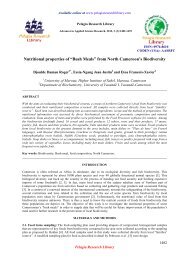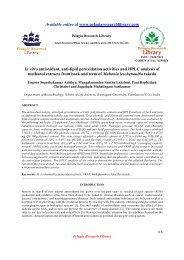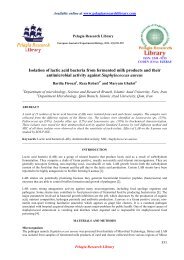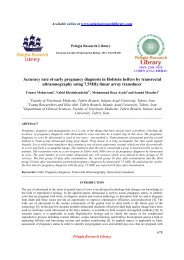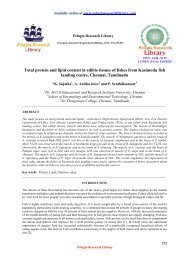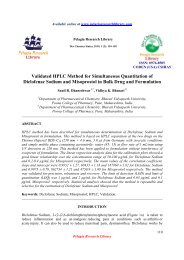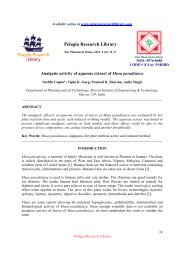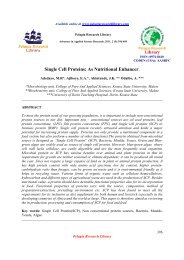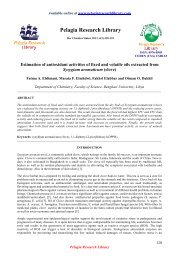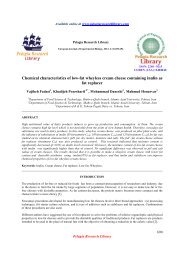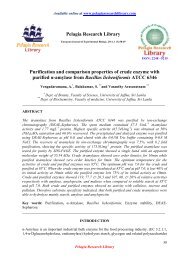Formulation and evaluation of fast dissolving tablet of - Pelagia ...
Formulation and evaluation of fast dissolving tablet of - Pelagia ...
Formulation and evaluation of fast dissolving tablet of - Pelagia ...
You also want an ePaper? Increase the reach of your titles
YUMPU automatically turns print PDFs into web optimized ePapers that Google loves.
Harish Ch<strong>and</strong>er et al Der Pharmacia Sinica, 2011, 2(6):163-170<br />
______________________________________________________________________________<br />
Ramipril is a prodrug <strong>and</strong> is converted to the active metabolite ramiprilat by liver esterase<br />
enzymes. Ramiprilat is mostly excreted by the kidneys. The half-life <strong>of</strong> ramiprilat is variable (8–<br />
18 hours) [12], <strong>and</strong> is prolonged by heart <strong>and</strong> liver failure, as well as kidney failure. It is mainly<br />
used for the Hypertension, Congestive heart failure, following myocardial infarction in patients<br />
with clinical evidence <strong>of</strong> heart failure. Susceptible patients over 55 years: prevention <strong>of</strong><br />
myocardial infarction, stroke, cardiovascular death or need <strong>of</strong> revascularization procedures,<br />
Diabetic nephropathy with microalbuminuria.<br />
The rate <strong>and</strong> extent <strong>of</strong> dissolution <strong>of</strong> the drug from any solid dosage form, determines the rate<br />
<strong>and</strong> extent <strong>of</strong> absorption <strong>of</strong> the drug. In the case <strong>of</strong> poorly water- soluble drugs, dissolution is the<br />
rate-limiting step in the process <strong>of</strong> drug absorption. Potential bioavailability problems are<br />
prevalent with highly lipophillic drugs (log p octanol/water, 3.32) due to erratic or incomplete<br />
absorption from GIT [6].<br />
Fast <strong>dissolving</strong> Tablet formulation has been widely <strong>and</strong> successfully applied to improve the<br />
dissolution, solubility, <strong>and</strong> consequently the bioavailability <strong>of</strong> poorly water-soluble drugs.<br />
Because <strong>of</strong> its poor aqueous solubility, Ramipril may pose dissolution related absorption<br />
problem. In the present study, an attempt had been made to prepare <strong>fast</strong> <strong>dissolving</strong> <strong>tablet</strong>s <strong>of</strong><br />
Ramipril in the oral cavity with enhanced dissolution rate & hence improved patient compliance<br />
using sodium bicarbonate <strong>and</strong> mannitol.<br />
MATERIALS AND METHODS<br />
Ramipril was received as gift sample from Torrent Pharmaceuticals Limited, Gujarat, India.<br />
Sodium bi carbonate, polyvinyl pyrrolidine, citric acid, magnesium Stearate were supplied by<br />
Central Drug House (P) Ltd., New Delhi, India <strong>and</strong> mannitol was supplied by Qualigens Fine<br />
Chemicals, Mumbai.<br />
2.1 Calibration Curve <strong>of</strong> Ramipril in 6.8 Ph Phosphate Buffer:<br />
2.1.1 Preparation <strong>of</strong> 6.8 pH phosphate buffer [13]:<br />
Prepare a 0.2 M solution <strong>of</strong> potassium dihydrogen phosphate by <strong>dissolving</strong> 27.218 gm <strong>of</strong><br />
substance in 1000 ml <strong>of</strong> distilled Water.<br />
Prepare a 0.2 M solution <strong>of</strong> sodium hydroxide solution by <strong>dissolving</strong> 8 gm <strong>of</strong> substance in<br />
1000 ml <strong>of</strong> distilled Water.<br />
Take 50 ml <strong>of</strong> above prepared potassium dihydrogen phosphate solution & 22.4 ml <strong>of</strong> above<br />
prepared sodium hydroxide solution. Add both the solution & make the volume <strong>of</strong> the resultant<br />
solution 200 ml. Calibrate the solution for using pH meter & adjust the pH 6.8.<br />
2.1.2 Preparation <strong>of</strong> stock solution:<br />
Dissolve 10 mg <strong>of</strong> Ramipril in few ml <strong>of</strong> phosphate buffer by taking 100 ml volumetric flask &<br />
make up the volume 100 ml to get a solution <strong>of</strong> 100 mcg/ml concentration solutions.<br />
2.1.3 Procedure:<br />
Prepare different concentrations from 10 mcg/ml to 60 mcg/ml by diluting stock solution as for<br />
first concentration 10 mcg/ml, take 1 ml <strong>of</strong> stock solution & dilute with 10 ml <strong>of</strong> buffer solution<br />
.Similarly other concentrations are prepared .Absorbance are measured at 231nm for each<br />
concentration by using UV spectrophotometer (UV-3000, Lab India).Concentration are plotted<br />
against absorbance on a graph paper.<br />
<strong>Pelagia</strong> Research Library<br />
164




